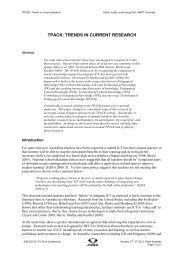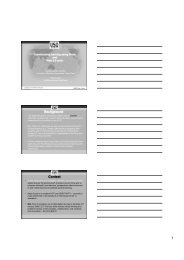ACCE Position Paper on ICT in the Australian Curriculum April 2011
ACCE Position Paper on ICT in the Australian Curriculum April 2011
ACCE Position Paper on ICT in the Australian Curriculum April 2011
Create successful ePaper yourself
Turn your PDF publications into a flip-book with our unique Google optimized e-Paper software.
<strong>the</strong> learn<strong>in</strong>g area as <strong>the</strong> ‘Technologies’ learn<strong>in</strong>g area, ra<strong>the</strong>r than as Informati<strong>on</strong> and Communicati<strong>on</strong><br />
Technologies and Design and Technology.<br />
Ano<strong>the</strong>r area of c<strong>on</strong>cern with <strong>the</strong> so called ‘Technologies’ Learn<strong>in</strong>g Area discussi<strong>on</strong>, both <strong>in</strong> <strong>the</strong> TEN<br />
draft proposal and <strong>in</strong> ACARA work<strong>in</strong>g papers for <strong>the</strong> December meet<strong>in</strong>g, is <strong>the</strong> extended use of <strong>the</strong><br />
term ‘technacy’. This term is of little value to <strong>the</strong> debate and fur<strong>the</strong>r enshr<strong>in</strong>es <strong>the</strong> design process<br />
framework. The term limits <strong>the</strong> scope of <strong>ICT</strong> and fails to acknowledge its unique qualities and<br />
complexities. <str<strong>on</strong>g>ACCE</str<strong>on</strong>g> is str<strong>on</strong>gly opposed to its use <strong>in</strong> any attempt to describe desired outcomes <strong>in</strong> <strong>ICT</strong><br />
learn<strong>in</strong>g and applicati<strong>on</strong> <strong>in</strong> schools and society.<br />
Currently <strong>the</strong>re is no published curriculum documentati<strong>on</strong> for <strong>ICT</strong> competence as a GC. Ra<strong>the</strong>r its<br />
place <strong>in</strong> <strong>the</strong> <strong>Australian</strong> <strong>Curriculum</strong> is recognised with<strong>in</strong> each of <strong>the</strong> four published learn<strong>in</strong>g areas,<br />
English, Ma<strong>the</strong>matics, Science and History through embedd<strong>in</strong>g <strong>in</strong> c<strong>on</strong>tent descripti<strong>on</strong>s and/or<br />
achievement standards and through an <strong>in</strong>troductory paragraph expla<strong>in</strong><strong>in</strong>g <strong>the</strong> role of <strong>ICT</strong> <strong>in</strong> that<br />
learn<strong>in</strong>g area.<br />
C<strong>on</strong>cerns with current positi<strong>on</strong><br />
There are c<strong>on</strong>cerns relat<strong>in</strong>g to:<br />
• <strong>the</strong> curriculum articulati<strong>on</strong> of <strong>ICT</strong> competence as a GC<br />
• <strong>the</strong> developmental pathways of <strong>ICT</strong> as a learn<strong>in</strong>g area<br />
• <strong>the</strong> relati<strong>on</strong>ship between both <strong>ICT</strong> competence and <strong>ICT</strong> as a learn<strong>in</strong>g area<br />
• removal of reference to <strong>ICT</strong> <strong>in</strong> <strong>the</strong> Technologies Learn<strong>in</strong>g Area – should be Informati<strong>on</strong> and<br />
Communicati<strong>on</strong> Technologies, and Design and Technology<br />
<strong>Curriculum</strong> articulati<strong>on</strong> of <strong>ICT</strong> competence<br />
The term ‘competence’ is of <strong>in</strong>terest. The European Qualificati<strong>on</strong> Framework (EQF, 2008) def<strong>in</strong>es<br />
competence as ‘<strong>the</strong> proven ability to use knowledge, skills and pers<strong>on</strong>al, social and/ or<br />
methodological abilities, <strong>in</strong> work or study situati<strong>on</strong>s and <strong>in</strong> professi<strong>on</strong>al and pers<strong>on</strong>al development’.<br />
In <strong>the</strong> same c<strong>on</strong>text, knowledge is def<strong>in</strong>ed as ‘<strong>the</strong> outcome of <strong>the</strong> assimilati<strong>on</strong> of <strong>in</strong>formati<strong>on</strong><br />
through learn<strong>in</strong>g’ and skill as ‘<strong>the</strong> ability to apply knowledge and use know-‐how to complete tasks<br />
and solve problems’ (p. 11).<br />
The understand<strong>in</strong>g of competence <strong>in</strong> this way dem<strong>on</strong>strates that <strong>ICT</strong> competence is a significantly<br />
more important set of attributes than those articulated with<strong>in</strong> <strong>the</strong> current General Capabilities<br />
documentati<strong>on</strong>. True <strong>ICT</strong> competence will support <strong>the</strong> shift to a knowledge-‐based society. It<br />
addresses <strong>the</strong> need for all students to acquire and apply a depth and breadth of <strong>ICT</strong> knowledge,<br />
skills, attitudes, values and ethics <strong>in</strong> order for <strong>the</strong>m to be successful learners, workers and active<br />
citizens. True <strong>ICT</strong> competence will result <strong>in</strong> a digitally literate, digitally fluent and digitally productive<br />
society. This can <strong>on</strong>ly be achieved through clearly articulated and developmentally appropriate<br />
curriculum and standards.<br />
Internati<strong>on</strong>al research is c<strong>on</strong>clusive <strong>in</strong> stat<strong>in</strong>g that <strong>the</strong> curriculum must be clear about expectati<strong>on</strong>s<br />
by establish<strong>in</strong>g standards. The c<strong>on</strong>ceptual basis <strong>on</strong> which all general capabilities are built is a<br />
c<strong>on</strong>t<strong>in</strong>uum − <strong>the</strong>re are no achievement standards, but ra<strong>the</strong>r broad statements of learn<strong>in</strong>g at vary<strong>in</strong>g<br />
year <strong>in</strong>tervals. For <strong>ICT</strong> competence this is years 2, 6 and 10, however for Literacy and Numeracy <strong>the</strong>y<br />
are at years 2, 4, 6, 8 and 10. The audience for <strong>the</strong>se c<strong>on</strong>t<strong>in</strong>ua was <strong>the</strong> writers of <strong>the</strong> learn<strong>in</strong>g areas<br />
for <strong>the</strong> purpose of determ<strong>in</strong><strong>in</strong>g how <strong>the</strong> GCs could be embedded, not for teachers implement<strong>in</strong>g <strong>the</strong><br />
curriculum. In English and Ma<strong>the</strong>matics standards are articulated <strong>in</strong> year-‐to-‐year levels and <strong>in</strong><br />
Science and History <strong>the</strong>y are <strong>in</strong> two year bands.<br />
2





